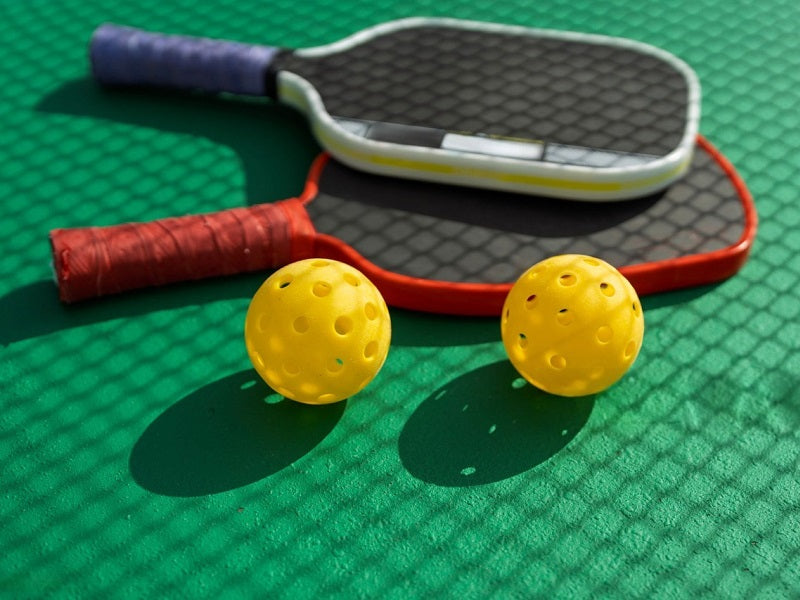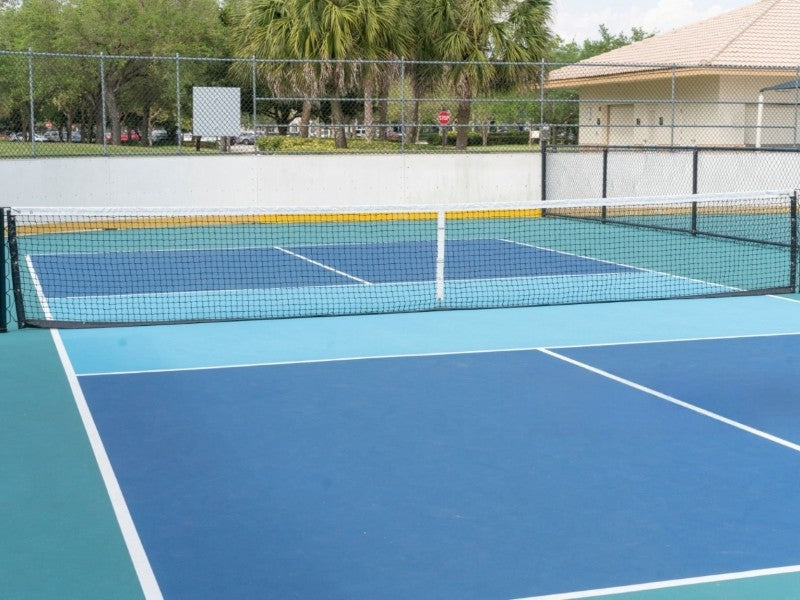Choosing the right paddle can feel overwhelming—so many materials, weights, and shapes to choose from. But here’s the truth: the “best” paddle isn’t the one everyone else uses; it’s the one that matches your skill level, play style, and comfort.
In short:
- Beginners should look for a light to midweight paddle with a forgiving polymer core and wide sweet spot for easier control.
- Intermediate players benefit from a balanced graphite or composite paddle that blends power and precision.
- Advanced players often prefer carbon fiber or custom-weighted paddles fine-tuned to their technique and swing speed.
The right paddle improves not just your performance—but also prevents fatigue, arm strain, and inconsistency. Let’s break down everything you need to know before you buy your next one.
Understanding Pickleball Paddle Anatomy: Why Each Spec Matters
Before you can choose wisely, you need to understand what makes paddles different. A pickleball paddle isn’t just a flat board with a handle; every component—from the face material to the grip size—affects how the paddle feels and performs.
1. Paddle Face Material
The face is the outer surface that contacts the ball. Modern paddles use one of four main materials:
- Graphite: Extremely light and responsive. It provides crisp control and is a favorite among players who value touch and finesse.
- Carbon Fiber: Similar to graphite but stiffer, offering extra power with less flex. It’s popular with competitive players seeking consistent response.
- Fiberglass (Composite): Slightly heavier, offers more ball “pop” and better energy transfer. Great for players who rely on powerful drives.
- Hybrid/Composite Blends: Combine materials (e.g., graphite + fiberglass) for balanced power and control.
Quick tip: If you love touch shots and net play, go graphite. If you’re a baseline power hitter, fiberglass or carbon fiber will serve you better.
2. Paddle Core Types

The core is the inner honeycomb structure sandwiched between paddle faces—it determines feel, sound, and ball response.
- Polymer (Polypropylene) Core: The most popular modern core. It’s quiet, durable, and offers excellent control. Perfect for recreational and club players.
- Nomex Core: Harder and louder, with a snappy feel and explosive power. Best suited for aggressive players who prioritize drive shots.
- Aluminum Core: Lightweight with great control but less power. A good option for beginners or players with joint sensitivity.
Key takeaway: Polymer = control & comfort; Nomex = power & pop; Aluminum = lightweight precision.
3. Weight and Balance
Weight is perhaps the single most important factor when choosing a paddle. It affects your swing speed, reaction time, and shot consistency.
- Lightweight (7.0–7.6 oz): Quicker maneuverability and faster hands at the net, but can lack drive. Ideal for doubles and defensive players.
- Midweight (7.7–8.3 oz): The “Goldilocks” range—balanced between control and power. Great all-around choice for most players.
- Heavyweight (8.4–9.5 oz): Offers maximum power and stability, but can tire your wrist and elbow faster. Favored by singles players or power hitters.
Beyond total weight, swing weight (how the paddle’s mass is distributed) also matters. A head-heavy paddle adds punch; a balanced one allows faster reactions.
4. Shape and Size
Not all paddles have the same silhouette. Each shape serves a purpose:
- Standard (16” × 8”): Classic design, balanced control and power.
- Elongated (up to 17” long): Adds reach and leverage for powerful drives, but reduces sweet-spot size.
- Widebody (under 16” long, over 8” wide): Ideal for beginners—larger sweet spot and more forgiveness.
- Hybrid shapes: Combine features (slightly elongated but still wide).
If you struggle with off-center hits, choose a widebody paddle. Advanced players who need reach and spin often go elongated.
5. Grip Size and Handle Length
Your grip controls paddle stability and wrist action. A wrong grip size can cause fatigue—or worse, tennis elbow.
To measure:
- Wrap your hand around a ruler (centered on your palm crease).
- The distance from the middle crease to the tip of your ring finger equals your ideal grip circumference.
Most adults fall between 4.0" and 4.5".
- Smaller grips (4.0"–4.25") → more wrist action, spin, and control.
- Larger grips (4.375"+) → more stability, less strain.
Handle length also varies:
- Short handles (4.5"–5") → better control for two-handed play.
- Longer handles (5.25"–6") → ideal for extra reach and power on serves and backhands.
6. Edge Guard and Surface Texture
A paddle’s edge guard protects it from court damage and keeps the core sealed. High-end paddles use lightweight, low-profile edge guards that don’t interfere with play.
Surface texture also matters—rough or gritty faces allow more spin, while smooth surfaces give cleaner contact for flat hitters. Be sure your paddle remains USAPA-approved, as excessive texture can make it illegal for sanctioned tournaments.
Choosing by Skill Level: What Matters Most at Each Stage
Once you understand paddle specs, the next step is matching them to your ability level and goals. A beginner’s paddle needs to build consistency; a professional’s paddle fine-tunes precision. Let’s break it down.
1. Beginners (0–6 Months of Play)
Beginners often struggle with timing, off-center hits, and inconsistent serves. The best paddle will help you focus on form without overcompensating for power.
Recommended specs:
- Weight: 7.4–7.9 oz (light to midweight).
- Shape: Widebody or standard.
- Core: Polymer for a softer, quieter feel.
- Face: Fiberglass or composite for forgiveness.
- Grip: Comfortable, slightly larger (4.25"–4.5").
Why it works: A lightweight, widebody paddle enlarges the sweet spot, so your shots stay on target even with imperfect form. The polymer core absorbs shock, reducing strain on wrists and elbows.
2. Recreational / Social Players (6 Months–2 Years)
At this stage, players start to develop a distinct style—some prefer controlled placement, others power drives.
Recommended specs:
- Weight: 7.8–8.2 oz (balanced).
- Core: Polymer or hybrid.
- Face: Graphite for control or fiberglass for more pop.
- Shape: Standard or slightly elongated.
- Grip: Medium (4.25"–4.375").
Why it works: Midweight paddles provide versatility—fast enough for reaction volleys but stable enough for drives. Graphite faces enhance feedback, letting you feel exactly how the ball connects.
3. Intermediate Competitive Players (2–4 Years)
You’ve mastered the fundamentals and are entering tournaments or league play. Now you need a paddle that responds precisely to your technique.
Recommended specs:
- Weight: 7.9–8.4 oz (mid to slightly heavy).
- Core: Polymer or Nomex hybrid.
- Face: Textured graphite or carbon fiber for spin control.
- Shape: Standard or elongated for reach.
- Grip: Medium-small (4.125"–4.25") for wrist mobility.
Why it works: Carbon fiber paddles with textured faces allow you to manipulate spin and control pace. The slightly heavier frame adds stability and consistency against harder shots.
4. Advanced / Tournament Players (4+ Years)
At this level, paddle choice becomes personal—micro-adjustments in weight and balance make a difference.
Recommended specs:
- Weight: 8.0–8.6 oz (depends on your play style).
- Face: Premium carbon fiber or thermoformed composite.
- Core: High-density polymer for stability.
- Shape: Elongated for reach or custom head-heavy for power.
- Grip: Narrow (4.0"–4.125") for wrist action.
Why it works: Pro-level paddles are tuned for maximum responsiveness and edge stability, letting you play precise dinks and powerful drives interchangeably.
5. Seniors, Juniors, and Special Considerations
Not every player fits neatly into a skill bracket. Physical comfort and ergonomics can matter more than performance specs.
- Seniors: Go for lightweight (7.0–7.6 oz) paddles with shock-absorbing polymer cores and thicker grips to protect wrists.
- Juniors: Look for smaller handle lengths (4.5"–5") and lower weights (<7.5 oz).
- Injury-prone players: Avoid stiff Nomex cores or heavy frames; choose flexible, vibration-dampening designs.

Best Practices for Matching Paddle to Play Style
By now, you know the specs—but how do they fit your style?
|
Play Style |
Recommended Paddle Features |
|
Power Player (drives & smashes) |
Heavyweight (8.2+ oz), stiff face, Nomex or carbon core |
|
Soft Game Specialist (dinks, resets) |
Midweight graphite, soft polymer core, widebody shape |
|
All-Around Player |
Balanced graphite/fiberglass hybrid, midweight |
|
Spin/Control Player |
Textured carbon fiber, elongated shape |
|
Defensive Doubles Player |
Lightweight, wide face for quick reaction volleys |
No two players swing the same way—so the perfect pickleball paddle is the one that complements your habits, not changes them.
Common Mistakes to Avoid When Choosing a Pickleball Paddle
Even experienced players fall into these traps:
1. Buying based on brand hype — Focus on how it feels, not marketing buzzwords.
2. Ignoring grip size — A poor fit leads to wrist strain and mis-hits.
3. Going too light — You’ll lose drive power and stability.
4. Going too heavy too soon — Causes fatigue and slower reactions.
5. Skipping demos — Always test before buying, especially for high-end paddles.
The goal isn’t to find the most expensive paddle—it’s to find your paddle.








Leave a comment
This site is protected by hCaptcha and the hCaptcha Privacy Policy and Terms of Service apply.